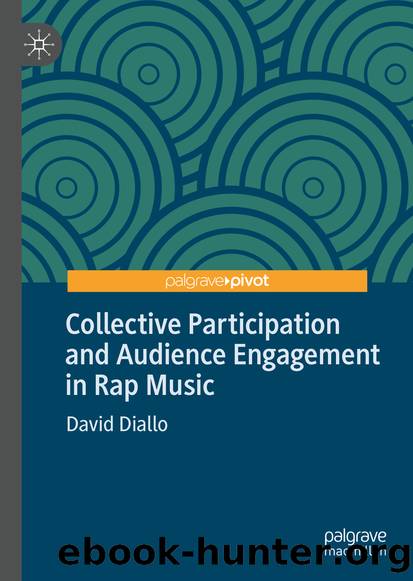Collective Participation and Audience Engagement in Rap Music by David Diallo

Author:David Diallo
Language: eng
Format: epub
ISBN: 9783030253776
Publisher: Springer International Publishing
According to Cheryl Keyes these formulas, like call-and-response, are a vital component of liveliness which help MCs manipulate time and effectively engage the audience (Keyes, 1984, p. 151). Similarly, the recurrent use of polyphonic interjections like âuhâ, âyeah,â âletâs goâ or âcâmonâ in rap songs further enhances this sought after live feel and reinforces the physicality of the recorded performance. The sense of presence and of physicality is also cultivated through the iterative use of cues like âyou know,â âyou see,â âlisten,â âwatchâ, âhey,â or by repeatedly asking the listener to âcheck it/this out.â The aforementioned interjections, while reinforcing the idea that the music is being performed live, also give the impression that the performance is spontaneous and unrehearsed, as if MCs needed to use fillers like the ubiquitous âyo!â (or âaiyo!â) to find their bearings on a beat. Such interjections, as I have already pointed out, were initially used in the late 1970s by MCs during live performances to adjust their flow to unexpected changes of breaks in a DJ mix (Kajikawa, 2015, p. 31). They also pepper freestyle performances where MCs recite âoff the topâ (i.e. unprepared) or pre-written rhymes on a beat. Improvised or semi-improvised sessions like those that can be heard on the popular radio show âSway in the Morningâ where guest MCs are challenged to rap on five different beats (the âFive Fingers of Deathâ), not knowing what they will be freestyling to until the next instrumental drops. MCs are then put in a situation similar to the one examined by Loren Kajikawa in his analysis of a Grandmaster Flash and the Furious Five 1978 live performance where Flashâs mixes were suddenly changing and his MCs resorted to such fillers profusely to adapt to new beats.
However, the fact that such gimmicks are used on recorded performances (where they could very well be edited out) confirms the ambition of the rappers to convey a live feel and a highly praised sense improvisation and spontaneity. This emphasis on spontaneity also testifies to the âone takeâ ethic which abounds in rap where MCs insist on presenting their studio performances as unedited, raw and very close to live conditions. For example, rapper Kendrick Lamar starts his song âRigarmortisâ with the line âAlright, here we go, third take, letâs go!â to draw attention to the challenging rendition of his intricate rapping in one take. The rap folklore abounds with stories of MCs coming into the booth and performing celebrated verses in one take (legend has it that âRapperâs Delight,â âSouth Bronx,â âN.Y. State of Mind,â âHard Knock Life,â or âLose Yourselfâ were recorded in one take.) This idea of spontaneity is recurrent in a rap discourse where MCs greatly value the idea of the inspiration of the moment, presenting their rhymes as if they were improvised, spontaneous or unrehearsed. Hence the insertion, generally at the beginning of a song, of bits like those presented below where MCs interact with the producer while getting ready to rhyme:
(3)
a - âTake the bassline out, uh huh, let it bumpâ (âHard Knock Life,â B&D, p.
Download
This site does not store any files on its server. We only index and link to content provided by other sites. Please contact the content providers to delete copyright contents if any and email us, we'll remove relevant links or contents immediately.
| Biographies | Business |
| History & Criticism | Instruments |
| Musical Genres | Recording & Sound |
| Reference | Songbooks |
| Theory, Composition & Performance |
The Goal (Off-Campus #4) by Elle Kennedy(13222)
Kathy Andrews Collection by Kathy Andrews(11361)
Diary of a Player by Brad Paisley(7277)
What Does This Button Do? by Bruce Dickinson(5944)
Assassin’s Fate by Robin Hobb(5879)
Big Little Lies by Liane Moriarty(5532)
Altered Sensations by David Pantalony(4884)
Pale Blue Dot by Carl Sagan(4652)
Sticky Fingers by Joe Hagan(3923)
The Death of the Heart by Elizabeth Bowen(3355)
The Heroin Diaries by Nikki Sixx(3339)
Beneath These Shadows by Meghan March(3162)
Confessions of a Video Vixen by Karrine Steffans(3118)
The Help by Kathryn Stockett(3025)
How Music Works by David Byrne(2976)
Jam by Jam (epub)(2890)
Harry Potter 4 - Harry Potter and The Goblet of Fire by J.K.Rowling(2831)
Strange Fascination: David Bowie: The Definitive Story by David Buckley(2706)
Petty: The Biography by Warren Zanes(2583)
